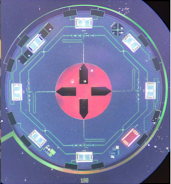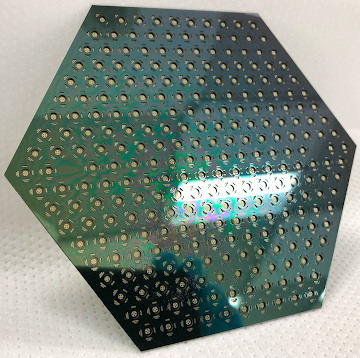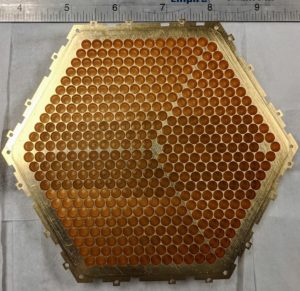Detectors

The detector technology for CMB-S4 is a superconducting bolometer, a thermal detector consisting of an absorbing structure that is thermally isolated from its surroundings. In this configuration, photons absorbed by the structure heat the device and produce a signal. We use superconducting Transition Edge Sensors (TES) to measure these small changes in bolometer temperature. The CMB-S4 TES detectors will have an operating temperature of approximately 0.1 K, which gives them exceptional sensitivity.

CMB-S4 detectors also include circuitry for processing the CMB photons prior to the thermal detection described above. The photon signal is separated into two linear polarizations using a planar Ortho-Mode Transducer (OMT). The signal from each polarization is separated into two different frequency bands by superconducting electronics before being absorbed and sensed by the TES. This detector technology has been used by many generations of CMB experiments; the challenge for the CMB-S4 project is that it requires 550,000 detectors distributed over about 500 wafers, which is an order of magnitude more detectors than any previous experiment.
Readout

The readout subsystem for CMB-S4 applies a stable and precise voltage to hundreds of TES bolometers on the detector wafers at 0.1K, and records tiny changes in current in each of the bolometers as the camera scans the CMB sky. The measured bolometer current needs to be amplified twice — once at 0.1K and again at 4K — inside the cryogenic camera before being transported to the outside. The current is amplified by very low-noise amplifiers called Superconducting Quantum Interference Devices (SQUIDs). Additionally, given the sheer number of signals to measure, using individual wires for each bolometer to transport signals from cryogenic temperatures to room temperature would leak in too much heat and prevent the camera from operating cold! So the SQUIDs are arranged on cryogenic silicon chips to “multiplex” the signals at 0.1 K, as shown in the adjoining picture. This means that instead of measuring every bolometer current signal simultaneously at 0.1K, the system quickly cycles one at a time through approx. 64 bolometers sharing one set of signal wires that connect to a 4K SQUID. Thus far fewer wires and 4K SQUIDs are necessary to amplify and transport signals to the warm outside. Once the signals are outside the camera, ordinary room temperature electronics attached to the CMB-S4 cameras will convert them to digital signals that can be transported to computers over ethernet cables.
Modules

CMB-S4 will field an order of magnitude more detectors than any currently planned CMB experiment. Though the detectors will go in a range of telescopes and cryostats, large and small, at their heart they will contain common detector modules. A detector module consists of a feed horn array that couples microwave light to detectors, which are readout with multiplexing electronics that allow many detectors to be readout on a single set of readout wires.
To verify the detector module design and performance, will require several development cycles of prototypes, pre-production, and production. These development cycles will require cooling down the detector module to its operating temperature (0.1 Kelvin), and will need to verify the performance of all the detector module components when integrated into a single unit.
For a detector module to be sensitive enough, it has to be cooled to very low temperatures (0.1 Kelvin), and to use superconducting materials for both the detectors and readout electronics. The technology has been used for previous generation CMB experiments, however CMB-S4 must also scale up the manufacture, assembly, and testing of the components by more than an order of magnitude. This scaling represents one of the main challenges of the CMB-S4 experiment, and is one of the motivations for the involvement of DOE national labs.